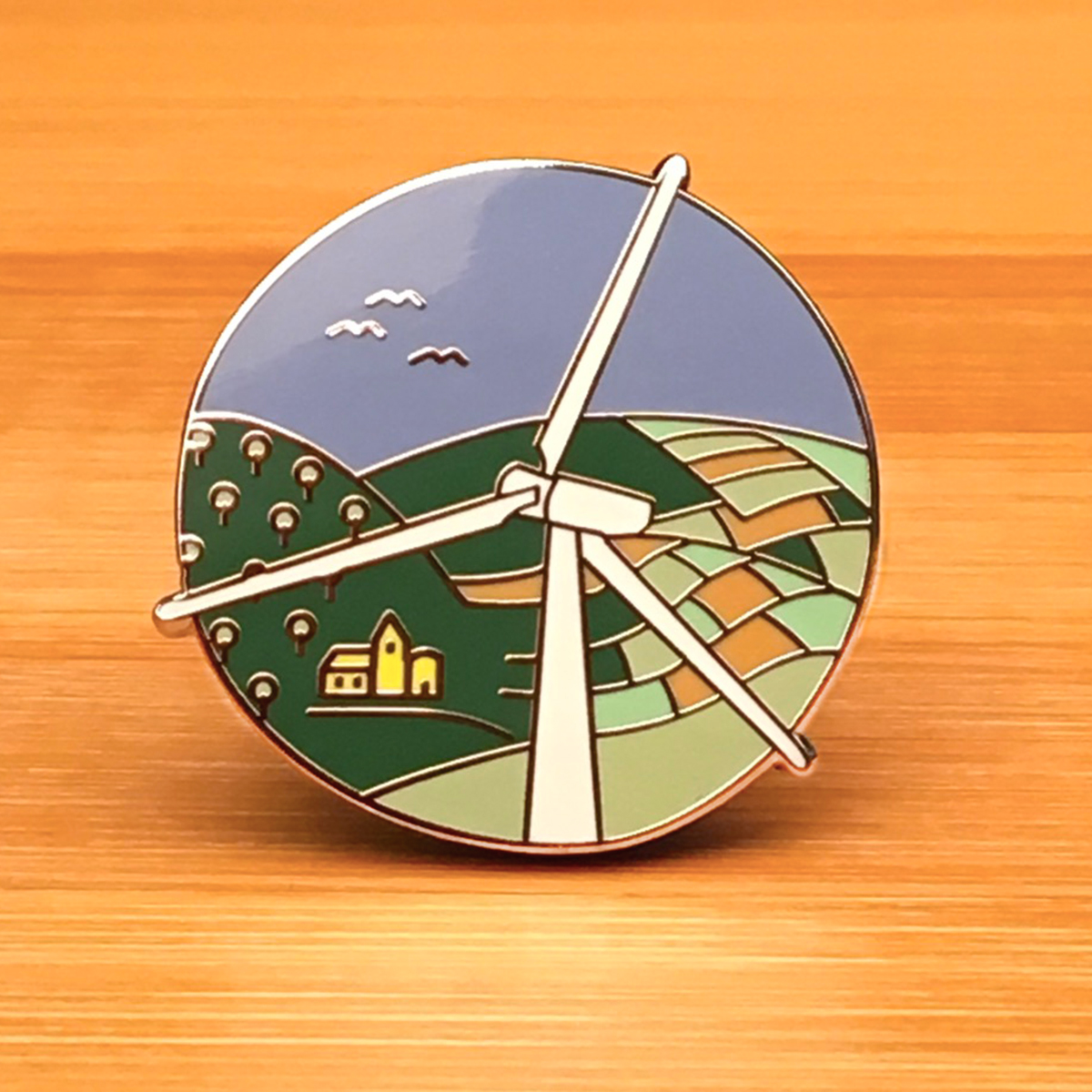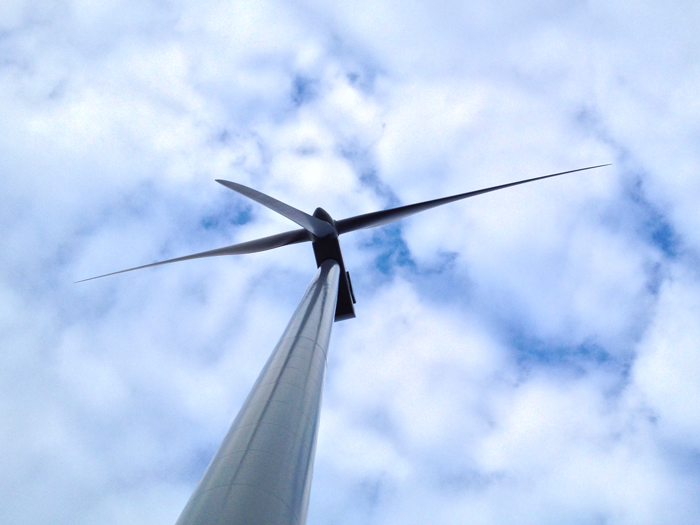The wind,
a fortuitous byproduct of solar radiation and the diversity of the earth’s surface. Just enough of a breeze keeps the bugs from bothering on a summer’s day, too much can be catastrophic. Somewhere in between the force of the wind can display a flag, propel a boat across the seas, or turn a shaft to a water pump or gearbox.
Wind-mechanical systems have served us for thousands of years. But having to situate the fan blades directly over the well pump has its limitations. Water wells are located in the best spot to draw water, not necessarily the best spot to catch wind.
Wind-electrical means being able to locate a turbine on the always windy side of the hill, then transport the electricity by wire to wherever the well pump is, or to the wood shop, the dairy, or the farmhouse. Battery back-up means having power during the calm periods.
Wind is free, and we’ll never run out of it as long as the sun shines and air exists around the planet. It makes sense to be exploring all the ways to harness that energy.
Wind Energy Numbers
According to the World Wind Energy Association, as of the end of 2018, the capacity of installed turbines worldwide had the potential to cover 6% of the world’s electricity needs. Denmark’s wind power reached a record 44% of the country’s electrical needs in 2017. An article on the US Energy Information Administration website claims that in 2016 wind turbines provided “8% of U.S. generating capacity, more than any other renewable source.”
That’s 8% from an energy source that is creating jobs, fueling economic growth in rural areas, and produces no, as in zero, carbon emissions. Wind energy cut enough sources of air pollution to translate into a public health savings of 8 billion dollars in 2017, according to the American Wind Energy Association (AWEA).
AWEA also points out that, compared with power plants that use more water for cooling than does agriculture in the US, wind turbine projects don’t use any water. Moreover, they have a physical footprint of about 2% of the land they are installed on, leaving the rest undisturbed and usable, and have “the lowest impacts on wildlife and their surrounding habitats of any large-scale way to generate electricity.”
Wind energy and birds
So, what about the birds? Bird fatalities is a favorite argument against wind energy. But consider some actual data.
According to this 2009 study, in 2006, wind farms in the US killed about 7000 birds. The study also noted that nuclear power plants killed about 327,000 and fossil-fueled power plants killed 14.5 million. Now consider this report from 2014 that found up to 988 million birds are killed each year by flying into our windows, 56 percent of those on low-rise buildings.
We kill 988 million birds a year just by living in buildings with windows. While we don’t see people proposing we stop installing windows, it should certainly not be an excuse not to do anything about the fraction killed by wind turbines, because there are things that can be, and are being done to lower the impact on the birds.
Consideration is now being made as to migration paths and habitat when deciding where to locate wind farms. Observation, sensors, and radar tracking, including the use of weather radar, can be used to know when to slow or shut down the turbines. And changes to turbine design, from shape to color, are being explored.
For the record, there are steps that can be taken to reduce the problem of bird-window collisions, but we will save that for another post.
Small wind
It’s not all about wind farms, or even offshore clusters. There is a growing market for ‘small wind,’ installing individual wind turbines at the location of the end user, and for smaller community installments. Innovations in small turbines, especially vertical designs, are making local generation more feasible and affordable.
Picture a typical suburban street. Each home has a basketball hoop, a TV or cable antenna or dish, a pole with electrical and phone wires, meter boxes, a mailbox… we have arguably unattractive units on our homes so ubiquitous and ingrained in our lives we don’t notice them. Unless you have one attractive enough to pass for a kinetic garden sculpture, paint a vertical wind turbine the same color as the house, or green as the trees, and it will become as invisible as it will be indispensable in no time.
Wind energy innovation
There are people who have decided, from personal experience, from misinformation, or to serve a political agenda, that wind energy is not worth pursuing. They claim a host of negative consequences for too little in return, painting with a broad brush and dismissing the need to explore.
I did not experience noise in any of my visits to a wind farm, but, I don’t live next door. For the bird issue, we can add that almost half of all the bird species in North America are “severely threatened” by global warming according to findings by the National Audubon Society. It stands to reason that one of the best things we can do for the birds is to curb emissions as much as possible, as soon as possible.
Fortunately, there are people around the globe curious and inventive enough to see how far we can take this. A quick search will find everything from offshore horizontal wind turbines with blades so long they can sweep an area of over 5 acres, to two blades that flap like hummingbirds, to convection chimneys, to turbines with vertical blades that take up little space and don’t have to fight gravity to rotate. And there are designs with no blades at all including a pole that oscillates, a dish that wiggles, and a belt that vibrates.
Not all attempts will prove to be more efficient or economically viable. But improvements will be found, and the path of out-there exploration is the way to discovery. Whatever percentage of our energy needs can be met by this non-polluting, non-water-using, free, and sustainable resource of wind energy is worth pursuing.
American Wind Energy Association
https://www.awea.org/
Audubon: The Climate Report
https://climate.audubon.org/
Sovacool, Benjamin K., 2009. “Contextualizing avian mortality: A preliminary appraisal of bird and bat fatalities from wind, fossil-fuel, and nuclear electricity,” Energy Policy, Elsevier, vol. 37(6), pages 2241-2248, June.
https://ideas.repec.org/a/eee/enepol/v37y2009i6p2241-2248.html
US Energy Information Administration
https://www.eia.gov/todayinenergy/detail.php?id=31032
World Wind Energy Association
https://wwindea.org/blog/2019/02/25/wind-power-capacity-worldwide-reaches-600-gw-539-gw-added-in-2018/


